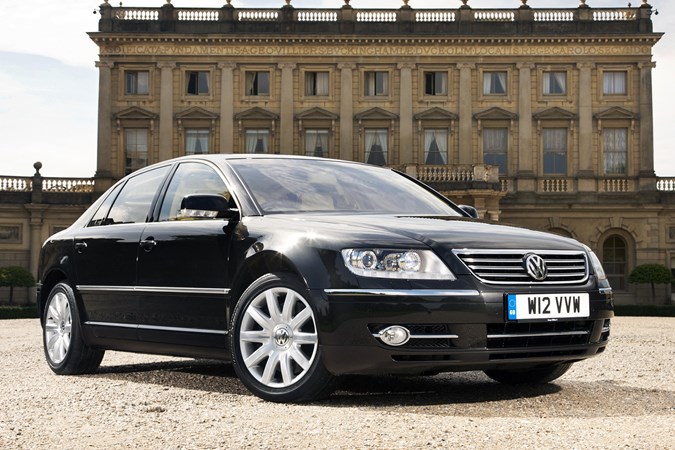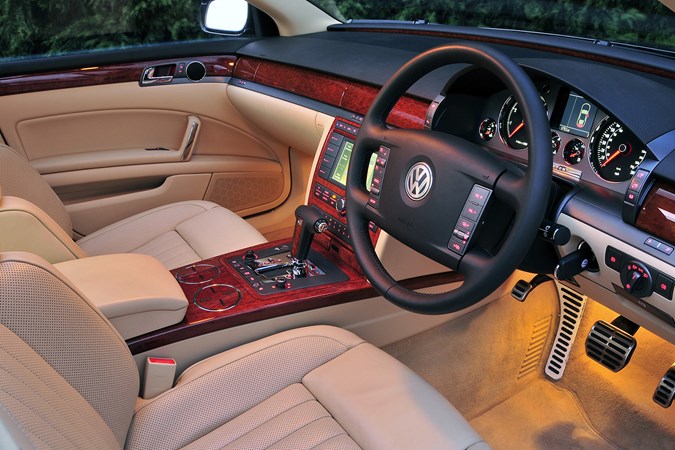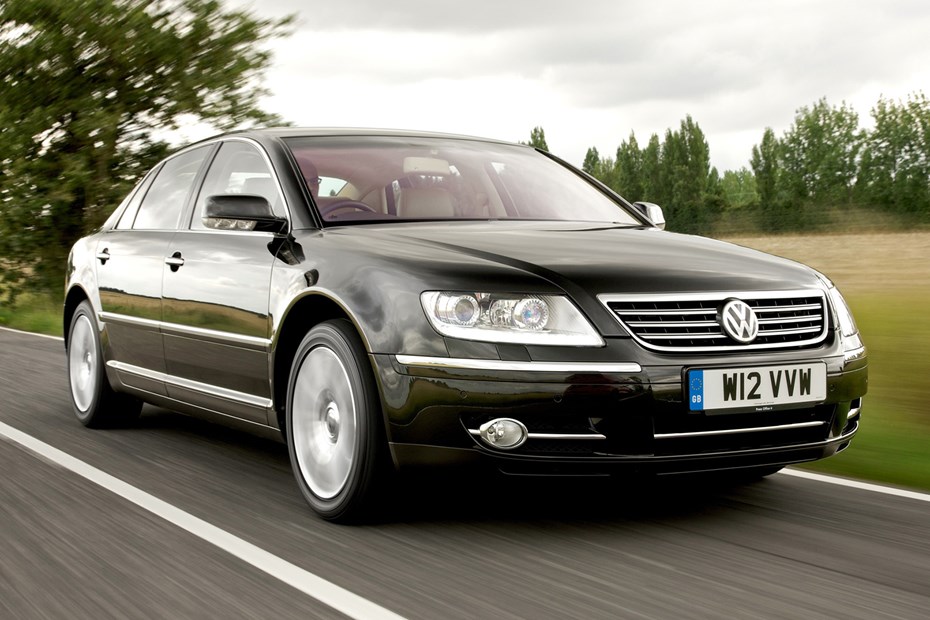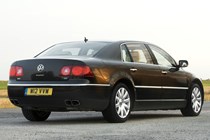Ryan’s still on holiday, so once again I’m taking the keys to ‘What could possibly go wrong?’ This week’s subject is one of my favourite obscure luxury cars – the Volkswagen Phaeton. A car VW built to prove it could take on the Mercedes-Benz S-Class and BMW 7 Series… and then watched barely anyone buy in the UK.
Launched in 2002, the Phaeton was VW overlord Ferdinand Piëch’s pet project – a rolling demonstration of VW’s engineering prowess. It came with a dizzying spec sheet: adaptive air suspension, double-glazed windows, four-zone climate control and all-wheel drive.
In W12 form, it borrowed its heart from the Bentley Continental GT, delivering a discreet 420hp and effortless 186mph cruising capability (if you switch out the 155mph limiter). But you didn’t need to go that far – diesels and V6 petrols made it slightly more attainable, if not exactly sensible.
Now? A decent Phaeton can be yours for less than the price of a five-year-old Dacia Sandero. Tempting? Absolutely. Sensible? Well…
Still fancy one? You brave, brave soul
Engines ranged from the relatively frugal 3.0-litre V6 TDI (good for 30+mpg on a run) to the magnificent 6.0-litre W12. In between sat a 4.2-litre V8 petrol and a 5.0-litre V10 TDI diesel, which was basically an oil-burning Bentley engine with the torque output of a tugboat. All versions came with 4Motion all-wheel drive and an air suspension system that could make potholes vanish.
For long-distance comfort, few cars do it better. It’s whisper-quiet at motorway speeds, stable in crosswinds, and grips like an Audi Quattro when the weather turns foul. But…

…what could possibly go wrong?
Quite a bit. The Phaeton is one of the most complex cars VW has ever built, and its Achilles’ heel is the very technology that makes it so impressive. Air suspension faults are common – leaking bags, tired compressors and failing control modules can result in an eye-watering bill.
Electrical gremlins are another hazard. The Phaeton has more ECUs than a small plane, and blocked scuttle drains can flood the cabin, taking climate control and infotainment units with them. Even minor faults can mean major labour time because of how tightly packed everything is.
The W12 is mechanically strong if serviced religiously, but it’s wedged in so tightly that routine jobs often require Bentley-like costs. The V10 TDI offers monstrous torque but is heavy on front suspension components, and injectors are wallet-emptying. Even the supposedly ‘sensible’ V6 diesels suffer from EGR, turbo and gearbox issues if neglected.
And then there’s the running costs: big tyres, huge brake discs and 20mpg at best in petrol form. Road tax isn’t kind either.
Yet, buy one with impeccable history and careful ownership, and the Phaeton can still be a sublime machine. They're available from £2,500, but to do so is scary even for me. Instead, spend £5,000-£7,000 on a cherished V6 diesel for maximum value. Lay out £8,000-£12,000 on a mint W12 or V10 TDI if you’re feeling bold – and keep a slush fund for when it sulks. Which it will.
To find out more, read our full Volkswagen Phaeton review.
Pros
- Incredible value for money
- Stealth luxury – flies under the radar
- Superb long-distance comfort
Cons
- Repairs can be ruinous
- Heavy on fuel and tax
- Finding a specialist can be tricky
FAQs: What you need to know about a used Volkswagen Phaeton
-
Is the Volkswagen Phaeton reliable?
Not especially, no. The engines themselves – even the W12 – are generally strong if serviced on time and with the right oil. The problems tend to come from the air suspension, complex electrics and the sheer number of control units onboard. Blocked drains can cause water ingress, which then kills expensive modules. Buy one with full service history and evidence of recent suspension and electrical work, and it can be dependable. Buy a neglected one, and you’re signing up for frustration.
-
Which is the best engine?
If you want the ‘sensible’ Phaeton, the 3.0-litre V6 TDI is the sweet spot – it has enough power, better economy and parts availability is reasonable. The 4.2-litre V8 petrol is silky-smooth and rare, while the V10 TDI is a torque monster but heavy on front suspension and frighteningly costly if it goes wrong. The W12 is the headline act – refined, discreetly rapid and the one to have if you want the full Phaeton experience, but only if you can stomach the fuel and servicing bills.
-
How much does it cost to run?
Even cheap-to-buy Phaetons are expensive to keep. Fuel economy ranges from 30mpg in the V6 diesel to mid-teens in the W12. Tyres, brakes and suspension parts are big-car money, and annual servicing is priced accordingly. Budget at least £1,500 a year for routine maintenance, more if you’re unlucky. Road tax is high on all models, and insurance can be pricey due to the car’s value when new.

Should you buy a Volkswagen Phaeton?
I’ve never owned one – but I’ve come perilously close more than once. I’ve typically walked away and bought an A6 or A8 instead, but I think that’s my loss. There’s something intoxicating about knowing you can get Bentley-level comfort for secondhand Ford Focus money. My head says ‘don’t’, my heart says ‘absolutely’.
When they work, they’re magnificent. You arrive after 400 miles feeling fresher than when you set off, the cabin cocooning you from the outside world. You glide through life without the attention an S-Class or 7 Series brings, which is a big part of the charm. I remember driving one to Poland and back in a long weekend – and being fresh for work on Monday. Perfect.
If you’ve got the budget to buy a good one and the willpower to walk away from ropey examples, a Phaeton could be the best luxury car bargain out there. Just remember – it’s not a car you can run on beer money, even if you bought it for peanuts.
Just so you know, we may receive a commission or other compensation from the links on this website - read why you should trust us.









